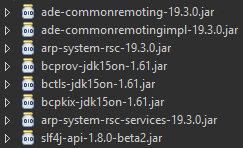Java RSC API ‒ Getting started
Valid with firmware releases up to 2024.6
Note:
The Java RSC API has been replaced by a better solution, see Using gPRC communication.
Therefore the support for this tool is already discontinued. If you decide to use the Java RSC API anyway you'll be on your own. The Java RSC API for Windows or for Linux must already be installed on your computer; it can't be downloaded from the Phoenix Contact website any more.
The Java RSC API has been replaced by a better solution, see Using gPRC communication.
Therefore the support for this tool is already discontinued. If you decide to use the Java RSC API anyway you'll be on your own. The Java RSC API for Windows or for Linux must already be installed on your computer; it can't be downloaded from the Phoenix Contact website any more.
The following steps describe the basic project setup for using the former Java RSC API.
- Add the JAR files of the projects
Ade.CommonRemotingAde.CommonRemotingImplArp.System.Rsc,Arp.System.Rsc.ServicesSLF4JandBouncyCastle
as project dependencies:

- If you are using Java™ 9 with the module system, add the module entries in the module-info.java file:
... requires com.phoenixcontact.arp.system.rsc; requires com.phoenixcontact.arp.system.rsc.services; ... - Define the connection properties.
NOTE: With default controller settings, the RSC service allows only secured connections, even if the application is executed on the device.import com.phoenixcontact.arp.system.rsc.ConnectionInfo; import com.phoenixcontact.arp.system.rsc.SecurityInfo;public class Example { public static void main(String[] args) throws Exception {// connection properties String hostname = "192.168.1.10"; // your controller IP int port = 41100; // The default port for RSC communication is 41100 int connectTimeout = 10000; int readTimeout = 10000; ConnectionInfo connectionInfo = new ConnectionInfo(hostname, port, connectTimeout, readTimeout; String username = "admin"; char[] password = new char[] { '1', '2', '3', '4' }; SecurityInfo securityInfo = new SecurityInfo(username, password); } } - Now create a new
ServiceManagerinstance and execute the connect method.// import for connection properties import com.phoenixcontact.arp.system.rsc.ConnectionInfo; import com.phoenixcontact.arp.system.rsc.SecurityInfo; // import for service manager import com.phoenixcontact.arp.system.rsc.ServiceManager; import java.util.Arrays;public class Example { public static void main(String[] args) throws Exception {// connection properties String hostname = "192.168.1.10"; int port = 41100; int connectTimeout = 10000; int readTimeout = 10000; ConnectionInfo connectionInfo = new ConnectionInfo(hostname, port, connectTimeout, readTimeout); String username = "admin"; char[] password = new char[] { '1', '2', '3', '4' }; SecurityInfo securityInfo = new SecurityInfo(username, password);// service manager try (ServiceManager serviceManager = new ServiceManager()) { serviceManager.connect(connectionInfo, securityInfo); } finally { Arrays.fill(password, '\0'); } } } -
Request and create a RSC service instance. Access a RSC service and execute a service method. If the requested service does not exist, the return value of
getService(…)will be zero.// import for connection properties import com.phoenixcontact.arp.system.rsc.ConnectionInfo; import com.phoenixcontact.arp.system.rsc.SecurityInfo; // import for service manager import com.phoenixcontact.arp.system.rsc.ServiceManager; import java.util.Arrays; // import for RSC service instance import com.phoenixcontact.arp.plc.domain.services.IPlcManagerService2; import com.phoenixcontact.arp.plc.domain.services.PlcStates;public class Example { public static void main(String[] args) throws Exception {// connection properties String hostname = "192.168.1.10"; int port = 41100; int connectTimeout = 10000; int readTimeout = 10000; ConnectionInfo connectionInfo = new ConnectionInfo(hostname, port, connectTimeout, readTimeout); String username = "admin"; char[] password = new char[] { '1', '2', '3', '4' }; SecurityInfo securityInfo = new SecurityInfo(username, password);// service manager try (ServiceManager serviceManager = new ServiceManager()) { serviceManager.connect(connectionInfo, securityInfo);// create a RSC service instance IPlcManagerService2 service = serviceManager.getService(IPlcManagerService2.class); PlcStates state = service.getPlcState(); System.out.println(state.getFlags());} finally { Arrays.fill(password, '\0'); } } }
See also
• Published/reviewed: 2025-12-18 ☃ Revision 087 •